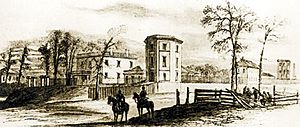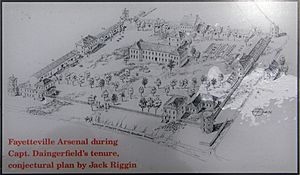Fayetteville Arsenal facts for kids
The Fayetteville Arsenal was a very important place in Fayetteville, North Carolina. It was built in 1838. The United States government decided to build more places like this after the War of 1812. They realized they needed more factories to make weapons and ammunition. These factories also needed to be spread out across the country. This way, no area would be too far from a place to get weapons if there was a war.
A man named James McKay, who was a representative from Bladen County, suggested building an arsenal in Fayetteville. The first stone for the Arsenal was put in place on April 9, 1838. The building was made of strong brick and stone. It had tall, eight-sided towers at each of its four corners. Huge iron gates controlled who could enter the Arsenal. Inside, there were workshops, living areas, and other buildings. These were also made of brick and wood.
The Arsenal During the Civil War
When North Carolina decided to leave the Union, Governor Ellis wanted to take control of the Fayetteville Arsenal. He asked Warren Winslow to try and get the Arsenal to surrender peacefully. General Walker Draughon, who led the North Carolina Militia, was ordered to take the Arsenal.
He gathered troops, including the Fayetteville Independent Light Infantry (FILI). This was the oldest private military group in the state, started in 1793. Major Wright Huske led them. The LaFayette Light Infantry, led by Capt. Joseph B. Starr, also joined. About 500 soldiers were there on April 22, 1861.
After the Confederate troops were inspected, the Federal officer, Lt. DeLagnel, saw that fighting would not work. He surrendered the Arsenal without any trouble. Union forces left the Arsenal on April 27, 1861.
Major Wright Huske and his FILI soldiers then moved into the Arsenal. They stayed there to protect the important property.
After the Confederate forces took the Arsenal at Harpers Ferry in April 1861, plans were made. The machines used to make rifles were moved from Harpers Ferry to Fayetteville. These machines were set up in October 1861. The Fayetteville Arsenal then became a main place for making small weapons for the Confederate army. The main weapon made there was called the Fayetteville Rifle.
At its busiest, the Arsenal made 500 rifles each month. It also produced other larger weapons, cartridges (bullets), swords, and bayonets. More than 100 workers from the Harpers Ferry Arsenal moved to Fayetteville with their families. In the middle years of the war, young women from the area also worked there. They made cartridges and worked as clerks.
In 1865, Union General William T. Sherman led his army on the Carolinas Campaign. It became clear that Fayetteville was a big target for him. When Sherman reached Columbia, South Carolina, Colonel Childs, the Confederate commander, ordered defenses to be built around Fayetteville. You can still see parts of these old earthworks (dirt walls) at the Veterans Administration Hospital on Ramsey Street today.
Confederate soldiers tried to fight back. But they were tired and outnumbered by Sherman's large army. Sherman entered Fayetteville on March 11, 1865. He took control of the Arsenal. However, the retreating Confederates had already removed all the weapons, ammunition, and useful machines. The rifle-making machines from Harpers Ferry were supposedly hidden in the coal mines of Egypt, North Carolina.
Sherman followed his "scorched earth" policy. This meant destroying anything that could help the enemy. He ordered the Arsenal to be torn down. His soldiers used railroad rails like giant battering rams to knock the buildings down. Then, they set the remains on fire. As the fire burned, some leftover artillery shells exploded. This completed the total destruction of the Arsenal.
What Remains Today
Not much of the original Arsenal is left at the actual site today. A main road was built through the area in 1988. There is one partial outbuilding (a small building separate from the main one) still standing. There is also a historical marker. Other pieces of the U.S. Arsenal are on display at the Museum of the Cape Fear Historical Complex. You can see the foundations (the underground bases) of the buildings that were along the back wall of the Arsenal. This includes the foundations of two of the towers. They are in the park behind the Museum of the Cape Fear.
The Arsenal site was added to the National Register of Historic Places in 1983.
The Fayetteville Independent Light Infantry website



